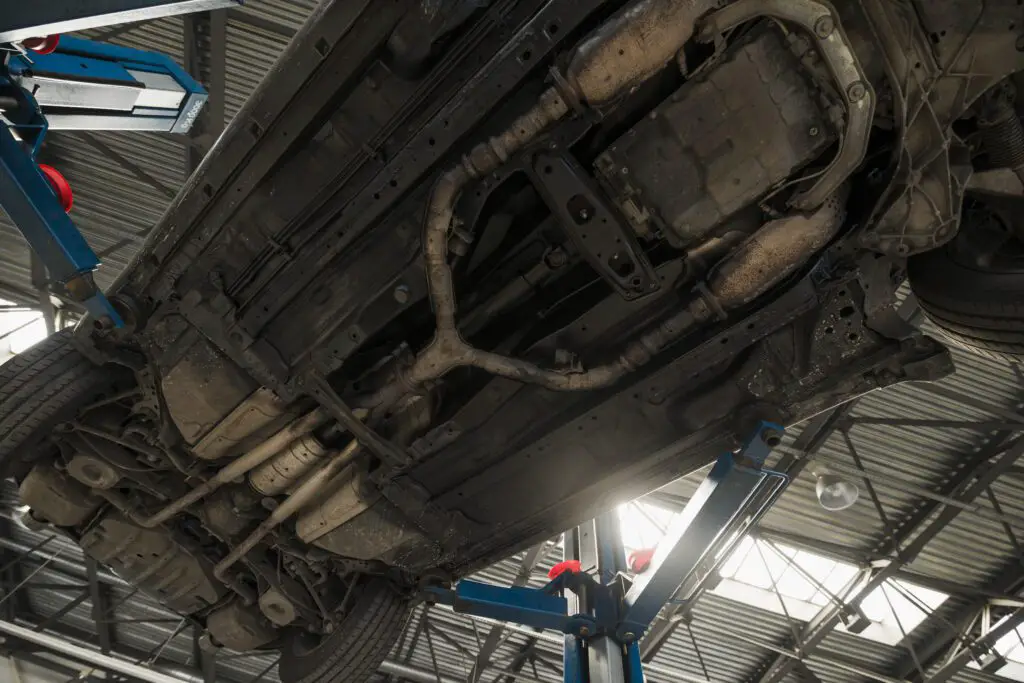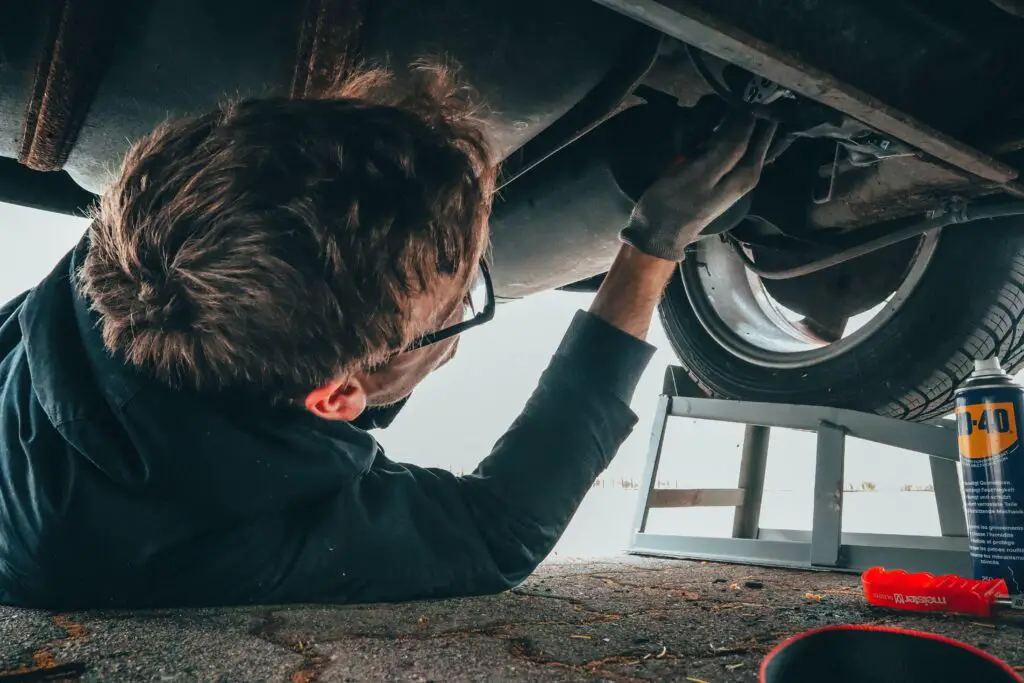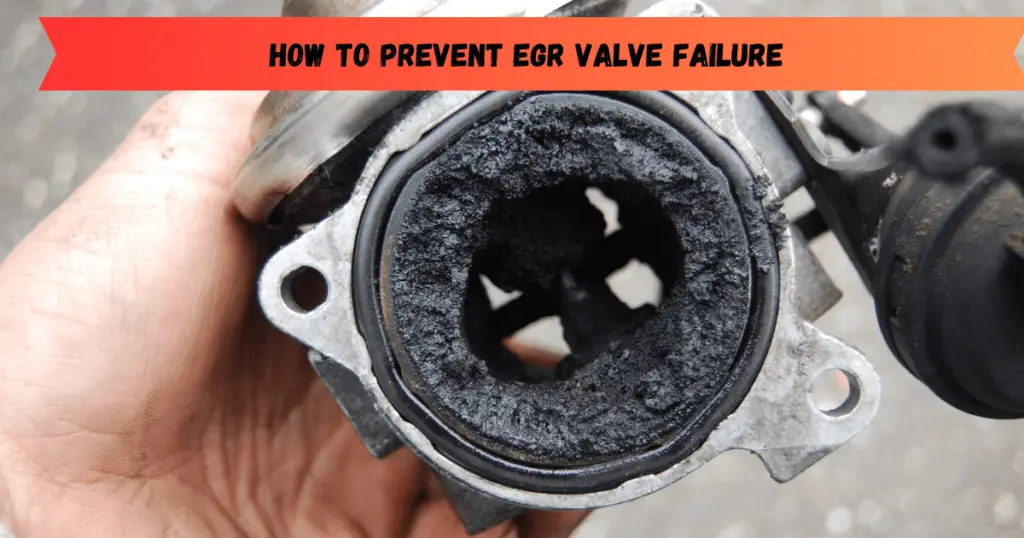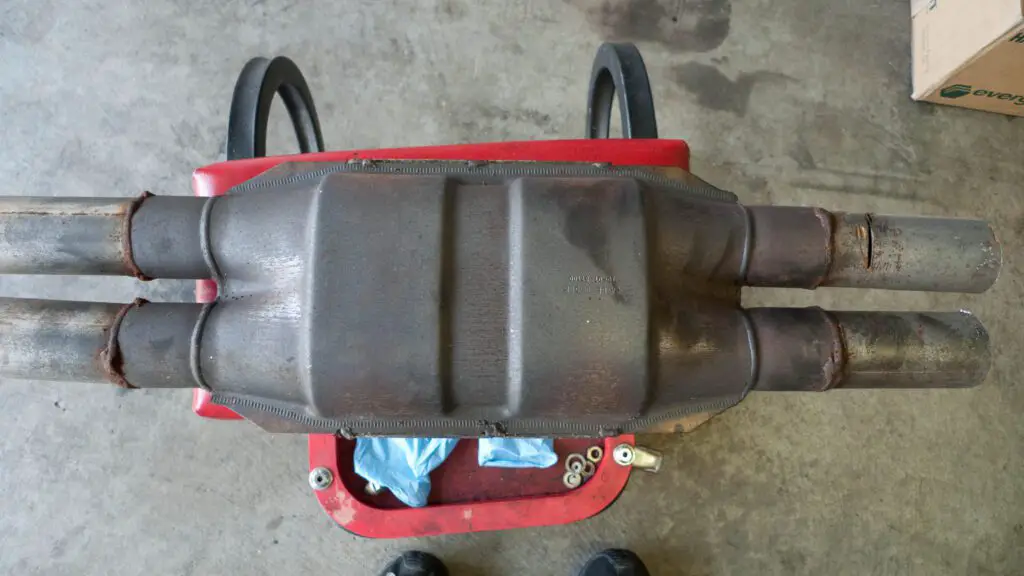Discovering an exhaust leak in your vehicle can be an alarming and frustrating situation. You may wonder – how long can I drive with an exhaust leak before getting it repaired? Should I continue normal driving or limit mileage? Could I face fines or failures of inspections?
This extensive guide will cover all aspects of How Long Can I Drive With An Exhaust Leak in great detail.
Let’s take a deep dive into exhaust system leaks and determine exactly how long you can safely drive for informed repair decisions.
What Causes Exhaust Leaks in Vehicles?
Before assessing how far or long you can drive, it’s important to understand what commonly causes exhaust leaks to occur:

Rust and Corrosion
The number one source of leaks is gradual rust and corrosion of exhaust components after years of use. Road chemicals, rain, snow, and salt accelerate corrosion and rust formation. Stainless steel systems resist rust longer, but most factory exhausts are made from standard mild steel.
Leaks often start as small pinholes and cracks that expand into larger holes or severed sections over time. Heat cycles expanding and contracting the metal also worsen corrosion fatigue.
Impact Damage
Driving over debris, potholes, steeply angled driveways, etc. can dent exhaust components inward. This crunches or fractures weld seams. Road impacts are a prime cause of flex pipe damage.
Leaking Gaskets, Seals and Clamps
Gaskets and ring seals at manifold, catalyst, and muffler connections eventually dry out and lose integrity. Leaks then develop at these once-sealed slip joints. Similarly, clamps can loosen over the years and cause leaks at connections.
Cracked Tubing
Pipes and tubing along the full system can develop cracks internally and externally. This is caused by extreme temperature differentials and long-term metal fatigue from heat cycles and vibration.
Loose Hangers
The various rubber hangers isolating the exhaust can rip or detach from the frame. This allows sections to sag and separate. Missing hangers is another common source of leaks at connections.
Modified Systems
Removal of catalytic converters, swapping mufflers, or DIY assemblies can often cause leaks at the various slip joints from improper seating, misaligned tubes, or inadequate clamps and gaskets.
Knowing the most prone areas and causes helps you inspect and diagnose developing leaks early before they become more severe. Catching issues early makes simple repairs possible.
How Long Can I Drive With An Exhaust Leak?
Technically How Long Can I Drive With An Exhaust Leak? for short distances without stranding you or immediately ruining the car? But there are compelling safety and mechanical reasons to minimize driving and have the leak repaired promptly:
Carbon Monoxide Poisoning
Any leak introduces harmful exhaust gases like carbon monoxide, sulfur dioxide, nitrogen oxides, and other toxic fumes into the cabin. Prolonged breathing of these gases can cause anything from headaches and nausea to unconsciousness and long-term neurological damage or death in severe cases. High CO levels are an extreme danger.
Fire Risk
Hot exhaust leaking out increases undercarriage temperatures and can ignite any flammable materials like oil, leaves, plastic fender liners, wiring, etc. This risk is heightened near the engine and fuel system. Large leaks significantly escalate the fire danger.
Loss of Power
Leak points disrupt exhaust scavenging and allow vacuum pressure leaks decreasing engine efficiency and throttle response. Expect noticeable power loss and sluggish acceleration as leaks worsen.
Fouled O2 Sensors
The leak bypasses the oxygen sensor tricking it into reporting incorrect air/fuel ratios. This causes check engine lights, dirty sensor elements, and skewed computer programming increasing fuel usage.
Failed Inspections
Even tiny exhaust leaks interfere with emissions equipment and cause automatic test rejection. Your car loses registration and ability to legally drive until passing inspection.
Noise
Larger leaks produce unpleasant drones within the cabin. This worsens with certain throttle positions that resonate through the leak. Noise levels are magnified without mufflers installed.
Weighing all these risks together, driving any more than short trips with known exhaust leaks is ill-advised until properly repairing the damage and sealing the system.
Estimating Exhaust Leak Severity
When discovering an exhaust leak, how do you determine its relative severity? There are several key indicators:
Noise Level
This is the easiest test. Have an assistant start the cold engine while you listen to the front, middle, and rear sections. Note where the hissing or roar emanates loudest. Also, revise slightly to change the noise pitch and volume. Quieter leaks are likely small. Loud hissing indicates a substantial breach.
Visual Cues
Safely look under the vehicle for obvious rupture points. Check the lake area for traces like soot, carbon staining, white condensation, and rust. Look for holes, separated pipes, detached mounts, and damage. A missing muffler or large dangling section points to a major failure.
Exhaust Fumes
Smell around the front wheel wells and cabin area with windows down. Strong exhaust or gasoline scents in the interior signal exhaust gases entering the vehicle. This represents an urgent hazard demanding immediate repair before driving.
Performance Changes
Test drive the car and push the engine across the RPM range. Listen and feel for power loss, hesitation, surging RPM, backfiring, or stalling which can indicate intake leaks. Monitor check engine lights suggesting engine management issues. These performance changes hint at leak severity.
Use these visible, audible, and sensory clues together to identify leak locations and gauge the overall extent of damage. This also helps determine the allowable drive time before repairs.
How Far Can You Drive With a Small Exhaust Leak?
For minor leaks only causing mild noise, here are general distance guidelines before repairs are critical:
- Pinhole or bolt leak – May drive up to 100 miles
- Small hole under 1/4 inch – 50 miles max
- 1/4 to 1/2 inch leak – 25 miles before repair
- Any mild interior exhaust smell – Tow to shop, don’t drive
These assume no acceleration issues or check engine lights. Any symptoms of performance loss or emissions disruption mean driving should be minimized even for small leaks. Monitor leak noises closely for increases.


When is an Exhaust Leak Considered Major?
How Long Can I Drive With An Exhaust Leak? Leaks expand into the severe category if:
- Over 1-inch diameter – Significant loss of exhaust out of a large rupture
- Complete disconnection – Full detachment of any section like the muffler
- Major fumes detected – Strong exhaust smell in the interior signals dangerous CO levels
- Visible smoke or fire – Seeing actual smoke or flames from the undercarriage
- Failed testing – An inspector deems the vehicle unfit to pass emissions standards
These major exhaust failures mean the vehicle should NOT be driven at all. Have it towed directly to a shop for diagnosis and repair before the leak worsens. Attempting to drive risks to health, safety, and further mechanical damage. For more information about damages read this Will an exhaust leak get worse over time?
Can I Temporarily Fix an Exhaust Leak Myself?
How Long Can I Drive With an Exhaust Leak? While not recommended for permanent repairs, there are some temporary solutions to patch exhaust leaks in a pinch briefly:
Exhaust tape – Fiberglass resin tapes like Exhaust Wrap or Muffler Mate can wrap over small cracks and holes temporarily. Use a heat-resistant sealing compound to coat tape edges.
Epoxy putty – Two-part epoxies like JB Weld are excellent for sealing the perimeter of leaks in sections that aren’t constantly moving.
Exhaust clamps – Several types of clamps can tighten over detached pipes or other junctions with minor leaks. Wideband clamps offer the most flexibility.
Rerouting – Carefully reroute sections away from large holes. Use additional tubing, clamps, and hangers to bypass major breach points.
These patches allow driving short distances to your mechanic and are handy for roadside repairs. But the leaks should still be properly repaired soon and not left indefinitely.
Fixing Common Exhaust Leak Points
Knowing the most prone leak locations helps target diagnosis and repair. Here are some to inspect closely:
Manifold – Cracked manifolds require replacement. Also recheck gaskets, clamps, and seals at the manifold/head junction. Heat cycles commonly loosen this joint.
O2 sensors – Sensor to exhaust port gaskets often fail. Reinstall sensors with high-temperature anti-seize on threads and replace fiber gaskets.
Flex pipes – Any tears in the accordion-style flex joints require replacing the entire flex section or exhaust part.
Catalytic converter – External holes can be patched but internal catalytic breakdown requires a new converter.
Resonators/Mufflers – Holes and detached baffles call for replacement. Try clamping and patching external holes first.
Mid pipe sections – Clamp slip joints that have separated or large corrosion holes internally necessitate replacing the full mid pipe.
Hangers – Broken rubber isolators lead to sagging and separations. Replace hangers immediately to avoid further damage from sagging and rattling.
Pinpointed repairs to specific leak locations are far cheaper than full system replacements if damage hasn’t spread widely yet.
Average Repair Costs by Vehicle and Leak Type
How Long Can I Drive With An Exhaust Leak ranges dramatically based on vehicle, location, and parts needed:
Economy cars – $200-$400
Small leaks: $150-$300 for clamps, hangers, patches
Section replacement: $300-$700 for pipes, resonator, muffler
Mid-size sedans – $350-$750
Small leaks: $250-$500
Section replacement: $500-$1000
Luxury cars – $500-$2000
Small leaks: $400-$1000
Section replacement: $1000-$3000
Trucks/SUVs – $250-$600
Small leaks: $150-$400
Section replacement: $400-$1200
Major repairs like replacing catalytic converters can run $1000-$2500+ in any vehicle due to parts cost.
Can You Pass Inspection With an Exhaust Leak?
Even very small exhaust leaks may trigger an automatic emissions test failure and prevent renewing your vehicle registration. OBD2 scanners check for air leaks causing emissions irregularities.
Some state exemptions allow driving a short distance for repair after failing before mandating fixes to pass. But any detectable leak makes passing unlikely until properly sealing the exhaust again. Repair your leak promptly to avoid fines or legal issues.
Preventing Exhaust Leaks Through Maintenance
Proper maintenance helps reduce the likelihood of exhaust leaks over your vehicle’s life:
Frequent undercarriage inspection – Periodically look for early leaks before major damage occurs. Look for rust, detached hangers, damaged sections, etc.
Address damage immediately – Fix impacts, dents, and holes early before cracks widen. Have sections straightened and welded if bent.
Keep protective coatings intact – Don’t remove factory rust inhibitors or allow paint coatings to wear off from scrapes.
Spray gaskets/seals – Use high-temperature silicone sprays on any rubber gaskets and ring seals when replacing or reinstalling exhaust parts to keep them pliable.
Check torque specs – Ensure clamps and flange bolts are tightened per manufacturer torque specs to avoid loose joints.
Clean exhaust regularly – Rinse road grime and debris frequently to avoid trapped moisture against metal causing accelerated rust and corrosion.
Frequently Asked Questions
Is it dangerous to drive with an exhaust leak?
Yes, any leak poses a significant safety hazard and risks mechanical damage. Have repairs done as soon as possible.
How much does it cost to fix an exhaust leak?
Anywhere from $150 for a patched flex pipe up to over $2000 for catalytic converter replacements on luxury vehicles. Most typical repairs run $300-$700.
Do exhaust leaks reduce horsepower?
Yes, even tiny leaks Lower engine efficiency through air intake leaks. A 1/4-inch hole could sap 10+ HP. Larger leaks promote bigger power losses.
Can you pass the emissions test with an exhaust leak?
Most leaks throw off readings enough to cause automatic failure. Only tiny leaks might still let you pass in some regions. Fix promptly to ensure passing tests.
Should I drive my car if there is an exhaust leak?
Avoid driving except short distances necessary to reach a mechanic. Have the car towed for major leaks. Shut off the engine immediately if you smell exhaust fumes inside.
Is it OK to JB Weld an exhaust leak?
For very small leaks under 1/4 inch, JB Weld can temporarily patch until professional repairs. Anything larger or on constantly moving components will likely fail again quickly.
How much does it cost to fix an exhaust manifold leak?
You’ll typically pay $350-$600 for manifold leak repairs – parts run $150-$350 and labor 1-2 hours. Full manifold replacements are often needed vs just gaskets.
Can I drive with an exhaust manifold leak?
Any manifold leak impacts performance significantly and requires prompt repair. Limit driving to essential short trips under 10 miles before fixing. Tow it if the leak seems severe.
Conclusion – How long can I drive with an exhaust leak
While exhaust leaks may seem harmless at first, prolonged driving with any size leak can quickly snowball into damaged components, decreased safety, and legal issues. Inspect frequently for early leak signs and address any issues immediately to avoid extensive repairs. Tow your vehicle or drive only minimally with major leaks present. Pay close attention to carbon monoxide symptoms or undercarriage fires. With early intervention, exhaust leaks and damage are very repairable.
But waiting leads to exponentially worse effects. Use diligent maintenance and inspection to reduce your risk and avoid situations where you must ask “How long can I drive with an exhaust leak?” For more information related to How Long Can I Drive With An Exhaust Leak check this article How Long Can I Drive With An Exhaust Leak?





